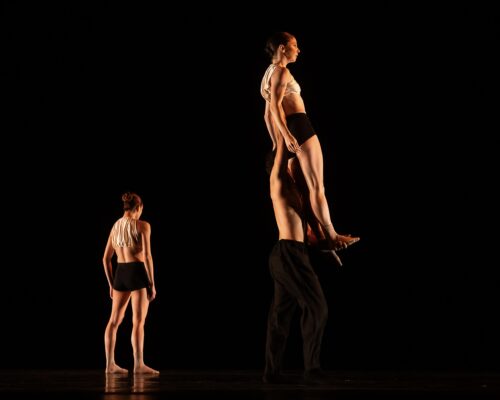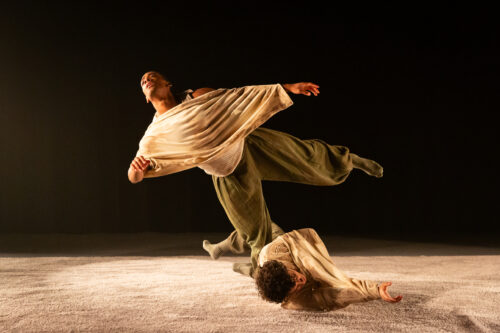Vitacca Ballet Gives Audiences the Works

In an evening of choreography by longtime collaborator Garrett Smith, Vitacca Ballet gave audiences the drama and dynamism, the precision and uplift that we have come to expect from the unstoppable five year-old company.
Smith is a Houston-trained dancer and choreographer who has been with Vitacca since its inception during the pandemic. Founder and Artistic Director Kelly Ann Vitacca described her company’s origin in an interstitial talk with the Smithworks audience, explaining how she adamantly kept creatively active while the performing world was shut down. In this way, as soon as it was safe to go back on stage, Vitacca was prepared and reached out to Smith to create a piece for their re-entry to the stage. That piece was 2022’s Somewhat Closer, which opened the Smithworks program.
The evening consisted of four works that Resident Choreographer Smith created on the Vitacca Ballet Company, presented chronologically and ending with the world premiere of Even Closer, which is more of a departure from previous work than the title suggests. Staged at The HobbyCenter’s Zilkha Hall, it may be the downtown location that cemented the idea of an urban setting for the pieces in this writer’s mind, because the set – or maybe anti-set – gives little indication of place. Smith wants all focus on the dancers, the living movement before the audience, both held and propelled by powerful, drama-filled scores. In most cases, lighting and light fog are the only elements the stage offers as context for movement, and while they might not specifically suggest a city, they are certainly not pastoral. The costumes suggest a time and place, or, more accurately, they describe a character from which one can infer a time and place. Interestingly and gorgeously, three of the four pieces use costumes that are – largely – genderblind. This emphasizes the unity of the corps and eliminates distraction and conjecture about identity or relationship that costume might encourage. Again, it is all about the movement for Smith. And, of course, the props. Smith pulls more out of his props than a magician. And you thought you knew what a hat was!

Somewhat Closer begins on a mostly dark stage with an artful duet that becomes a trio. In time, the entire company is on stage backlit by a blue screen. The dancers are confident, earnest, and athletic. Later, light comes from the side of the stage like a clerestory while a trio performs Pieta-esque formations. Something about this piece feels like an epic journey, the characters excited and dynamic. It ends with a family-like trio – what reads as two adults and a child – united to face both the past and the future. As a post-pandemic piece, it is easy to imagine that Somewhat Closer is about a reckoning of time and occurrences, as well as an unknowable future, though in the program notes Smith highlights relationships and the return to a familiar place in his creation of this piece. The two notions are not at odds; what gives time significance if not the relationships that develop and change within it? And what is more active and charged than the space between people?
The second piece in the program, Hypnotic Forces, begins whimsically, with a wide-brimmed black fedora far downstage and a pair of black, laced jazz shoes hanging to the audience’s far right. We hear the sounds of a train as the hat advances slowly across the stage toward the shoes. The sounds louden, the hat exits to the right, the shoes are pulled up into darkness, and we are primed for something fanciful.
The dancers are wearing knickerbockers, Oxford boots, and the fedoras, all in black. In the program notes, Smith discusses German musician Nils Frahm, whose music the piece is set to as bridging classical and electronic music in a way that inspires a fresh, innovative response to a set and formalized system. While the costumes are mostly stylish and cool, they – paired with the minimalist pas-de-deux of hat and shoes – also suggest a time of industrialization when what was venerable and proven suddenly became background for what was explosive, fast, and new.
The movement in Hypnotic Forces feels like routines or rituals, performed with energy and precision by the company as individuals, neither needing nor seeming to notice each other in their pursuit of action or completion of their movements. These performances are both communal and isolated. Eventually a trio forms that acknowledges each other’s bodies, but still feels like it – the trio – is in the same zone of purpose as are the individuals. The trio isn’t so much interacting as just acting in order to accomplish…whatever the work or ritual is meant to accomplish. Unlike Somewhat Closer, while the choreography is similarly vigorous and refined, Hypnotic Forces has a feeling of urgency with an underlying threat that the dancers are working to avoid. At one point, after considerable action, a few dancers, one by one, become circumspect, responding to their environment, but even their awareness feels like a survival instinct rather than a liberation. At the end of this movement, something arrives or happens behind the audience that causes the action to stop. The dancers look toward the back of the auditorium and leave the stage slowly, singly, as if they are not safe to continue but they are also not compelled to flee.
We must discuss the hats. In the first movement of Hypnotic Forces, the hats are costume. They are taken full advantage of in the choreography, being tipped, traded, used to hide faces, indicate direction, and whimsically wiggle. In the second half, they are occasionally absent or doubled, and they stand in as food, faces, containers for soundless screams. They are thrown, spun, grasped, eaten, abused, treasured, and forgotten. Configurations of dancers tell an overlapping cacophony of stories with the hat as throughline. Rarely has one object accomplished such an abundance of roles. The heroic hat. The second movement ends similarly to the first, with something behind the audience quietly compelling the dancers off stage. The final movement of Hypnotic Forces is both queer and superb. It is still a rarity in Houston dance, especially in a show on a mainstream stage from an esteemed dance company, to see men in a relationship that is tenderly intimate and powerfully physical. In this movement, it feels that Smith is exploring long love, the kind with fidelity and sweetness and anger and the struggle of making room for two lives in one defined unit, and keeping that unit fair and vital. The choreography is intricate and forceful, sculptural in form. It constantly seeks and requires balance and constantly seeks and requires adjustment and change. Smith’s vocabulary of movement absolutely sings in this dance, and is impactful in that transcendent way that great art – made of pure effort and honesty – can be.

The third piece, After Silence, is also built around a worn prop that similarly serves a multitude of purposes. In this case, the costume – dirt-streaked brown pants and white tops – suggests struggle and insufficiency. The dancers begin prostrate on the stage with their heads covered by what at first might be a sheet but is revealed to be a shawl-like top worn around the neck and torso. As they come to movement, the clothing becomes a tool for shape and resistance á la Martha Graham. The dancers fight and manipulate the clothing in every way imaginable without removing it. It is torture, it is comfort, and it is everything in between, including unpredictable. As they dance, a movement is repeated wherein the dancer’s mouth is open in a silent scream that is covered by their own hand.
It is a huge relief when the tops are removed and thrown off stage, though afterward to choral music, the dancers touch their bodies in a discomfited way, as if they are uncertain, insufficient things. Then there is a suggestion of a death, possibly of redemption, certainly of transformation, because the dancers then unify into creature-like formations made up of the entire company. The creatures adjust and change, but they remain a singular moving entity, capable and precise just like the dancers that form them.
After a series of impressive sock-footed slides across the stage, it became apparent that there was a fabric covering on the floor (this was probably obvious from most seats in the house, but it took time to register to those below the stage). After some slippery levity, the constricting shirts reappear and movements become desperate and futile. It’s all bad. Finally, a dancer, alone and terrified by something off stage rolls themselves up in the floor covering, then is joined by the rest of the company who, standing, pull the other side of the cover up to their noses like frightened children in bed, after which the soloist climbs over their sheet/wall to join the group. This ending had a hint of play and make-believe that felt at odds with the seriousness of the shirts. Smith says that the piece is inspired by the death of Mahsa Amini in Iran in 2022, and it is easy to understand the dancers’ reactions to their tops as responses to the abaya or hijab, or anything one lives in that is both antiquated and enforced. After Silence is a protest dance that has only become more relevant since it premiered as the world continues to struggle, to unite, and to hide.
The final piece, Even Closer, is fully narrative – it even has dialogue and a stage set. It is the story of a child – a son – and their mother from his birth to her old age. It is full of tenderness and devotion, and the dancers nail each dramatic note. Three dancers play the son at different ages in his life – Joshua Ponton, Nikolas Darrough, and Jordan Hooks, consecutively — while the Melody Mennite portrays the mother throughout. Props are introduced from the beginning, as a swarm of black robe and hood-clad dancers carry in a swaddled glowing soul in a dance that swirls around the stage, leaving it in the loving arms of the mother seated in a large, comfortable chair. The “choir” of dancers are described as “Time Keepers” in the program, and the name is appreciated as a way to understand what might otherwise read as talented, enthusiastic, overdressed stagehands flowing through the scenes. Time is the subject of the play, and these Keepers move it forward with deft efficiency.
As the boy grows, his childhood is represented by a floppy toy rabbit that the two characters play with and with whom the boy shares secrets. A schoolbag is worn home as the boy grows, traded for a briefcase in his adulthood. The mother ages, too, and acquires a cane and grey hair by this third phase of the story, and their roles have reversed, with the boy now carrying his mother, playfully yet cautiously dancing her around the home. Is this plot familiar? The program states that the dance is based on the popular Robert Munsch picture book Love You Forever, and, like the book, Smith’s dance may or may not have choked up this writer and mother of a too-quickly growing son.
Again, the dancers play their roles with dramatic precision, and it is a moving piece full of heart-tugging moments that is a significant tonal and structural departure from the other pieces in the program. It is impressive, but not surprising, that the Vitacca Ballet dancers were able to take this dramatic turn.
Smithworks covers four prolific years of premieres from the potent dancemaking fusion of Garrett Smith and the Vitacca Ballet team. Houston and the dance world look forward to the continued evolution of this company, this choreographer, and their astounding combination.



Recent Comments